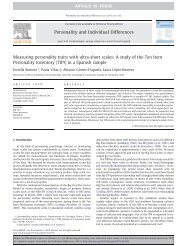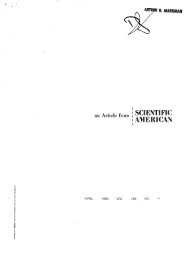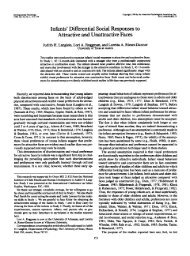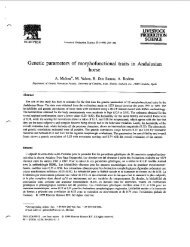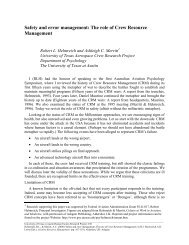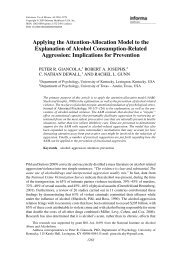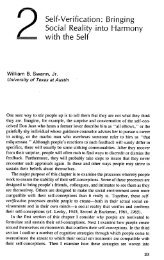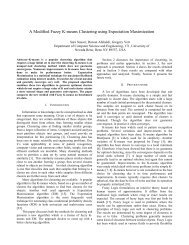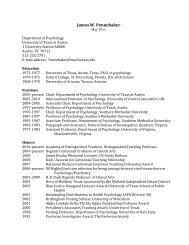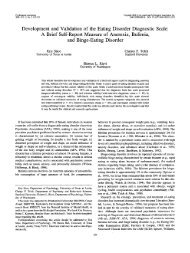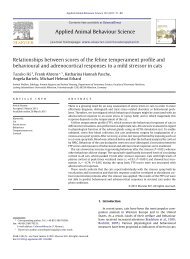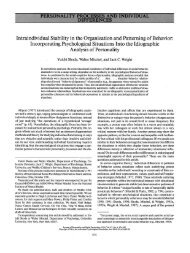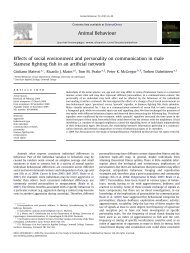The Word-Length Effect and Disyllabic Words (Lovatt
The Word-Length Effect and Disyllabic Words (Lovatt
The Word-Length Effect and Disyllabic Words (Lovatt
You also want an ePaper? Increase the reach of your titles
YUMPU automatically turns print PDFs into web optimized ePapers that Google loves.
THE WORD-LENGTH EFFECT 17<br />
cultural <strong>and</strong> educational differences may contribute (see Stigler et al., 1986). Two ®ndings<br />
are in direct con¯ict with the st<strong>and</strong>ard model regarding memory span <strong>and</strong> speech rate.<br />
First, in a study of young children Chen <strong>and</strong> Stevenson (1988) found that Chinese±<br />
English differences in digit span remained even after regression on list duration. Second,<br />
Cheung <strong>and</strong> Kemper (1993) found that the gradient of the span/speech rate function was<br />
much steeper in Chinese adults than in English. Cheung <strong>and</strong> Kemper ascribed the change<br />
in slope to the disproportionately high span scores for Chinese monosyllables, <strong>and</strong> they<br />
pointed out that Chinese monosyllables have low phonological complexity (syllables are<br />
CV or CVC), in contrast to English monosyllables, which may contain consonant clusters.<br />
Thus, although it is appealing to explain cross-linguistic differences in word <strong>and</strong> digit<br />
span in terms of word duration, the supporting evidence is not conclusive.<br />
Individual Differences<br />
Many studies have shown that individuals who speak faster generally have increased<br />
memory spans (e.g. Baddeley et al., 1975; Ellis & Hennelly, 1980; Hulme et al., 1984;<br />
Schweickert & Boruff, 1986). However, this could be explain ed by more ef®cient speech<br />
buffering (e.g. Monsell, 1987) or speech planning (Caplan et al., 1992) leading to<br />
enhanced speech rates, rather than by speech rate itself determining memory capacity.<br />
In a recent study Smyth <strong>and</strong> Scholey (1996) reported a signi®cant relationship between<br />
articulation rate <strong>and</strong> digit span, but they also found that articulation rate predicted<br />
performance equally well on a number of visual <strong>and</strong> spatial memory tasks, some of<br />
them quite unlike serial recall. <strong>The</strong>y proposed that speech rate is a general measure of<br />
processing speed, <strong>and</strong> as such is related to many cognitive skills.<br />
Thus it is possible to account for the relationship between speech rate <strong>and</strong> memory span<br />
across syllabic length, languages, <strong>and</strong> individu als without invoking an explanation in terms<br />
of phonological decay offset by rehearsal or output rates. <strong>The</strong> most direct evidence for an<br />
effect of word duration, <strong>and</strong> hence of decay in phonological short-term memory, has been<br />
the effect of word duration across controlled sets of disyllables, an effect which is<br />
questionable, given the evidence presented here. One way to sustain the decay theory<br />
would be to propose that rehearsal rates are not re¯ected in speech rates, possibly because<br />
they represent a more abstract code. This proposal con¯icts with subjective reports of<br />
rehearsal, <strong>and</strong> it would considerably weaken the utility of the theory, as speech rate could<br />
no longer be used to predict span. Nevertheless, a theory of this type could account for the<br />
lack of a relationship between duration <strong>and</strong> span in the present ®ndings, <strong>and</strong> it could<br />
provide a general account of word-length effects if rehearsal was governed by syllabic length.<br />
Several recent models of the word-length effect have not included rehearsal assumptions<br />
(e.g. Anderson & Matessa, 1997; Brown & Hulme, 1995; Neath & Nairne, 1995).<br />
However, all of these models suggest that the amount of decay or interference that occurs<br />
is determined by the duration of items, whereby longer duration items suffer more decay<br />
or interference. <strong>The</strong>refore, these models make the same prediction as does the st<strong>and</strong>ard<br />
model (Baddeley, 1986) concerning word-duration effects in disyllables.<br />
<strong>The</strong> present ®ndings have implicatio ns for those studies that manipulated lists or recall<br />
methods to control output delay (Avons et al., 1994; Cowan et al., 1992; Cowan, Wood, &



